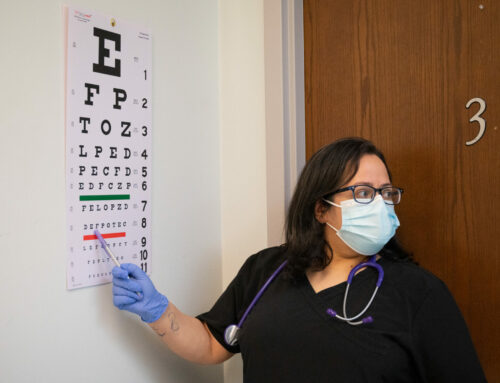News
STD Awareness

By Tapestry 360 Health Provider
Working at a school-based health center, I perform a lot of STD testing, some for students requesting the test due to risky behaviors, others just as routine screening with their annual physical exams. It is always surprising how many positive tests we get on patients who think they are not at risk or who have no symptoms at all. That is why I encourage all sexually active persons to “Get Yourself Tested” as the popular campaign by MTV suggests.
According to the Centers for Disease Control (CDC), there are 20 million new STD cases every year. The most frequently reported STD is Chlamydia. It is estimated that 1 in 15 sexually active females aged 14-19 years has chlamydia. Though often this disease causes no symptoms at all, it can sometimes cause an abnormal discharge from the penis or vagina or burning pain with urination. If left untreated, this disease can travel up into the reproductive tract and cause a severe infection and also to infertility later on.
Gonorrhea is a disease similar to chlamydia and can have either similar symptoms (vaginal or penile discharge, burning pain with urination) or no symptoms at all. Like Chlamydia, Gonorrhea can also affect your fertility or cause a severe infection in the reproductive tract that could require hospitalization. Because there are such severe consequences to a disease which often has no symptoms, I do recommend at least yearly testing for these diseases, especially those in the most at-risk age group of 25 and younger. Testing for gonorrhea and chlamydia can be done by a simple urine test or by a swab of the urethra (opening in the penis) or the cervix (opening of the uterus).
HIV/AIDS is one STD everyone knows about but no one thinks they will get. HIV has no symptoms in its early stages so a person could be infected for several years and not be aware of it. The virus attacks your immune system, which leaves it open to numerous infections that your body cannot fight, which, if severe, can lead to death. Though there are many medications now which effectively control HIV, there is no cure. The medications taken for HIV need to be taken for life and most have side effects. The CDC recommends testing for HIV in everyone, with yearly testing for those at higher risk. Testing for HIV is usually done via a blood test, however, there are some sites where testing can be done by a simple swab of your mouth.
Syphilis is another STD which is fairly common in the United States. Syphilis has symptoms which come in stages. In the primary stage, you may have a painless sore on the genitals for several weeks. In the secondary stage you may have a rash on your palms and/or sores in your mouth, fever, swollen lymph glands, sore throat, patchy hair loss, headaches, weight loss, muscle aches, and fatigue. The late/latent stage of syphilis can occur 10-30 years after the initial infection and causes damage to a number of internal organs like the brain, nerves, heart, etc. This damage can cause dementia, blindness, paralysis and eventually death. Testing for syphilis is done via blood test.
This is not a complete list of STDs, but please talk to your health care provider regarding your risks and what tests should be done. Testing for all the above STDs can be done at all of the Tapestry 360 Health. However, the most important point I want to make is to prevent these diseases from happening to you. While some of the diseases can be treated with antibiotics, some, like HIV/AIDS have no cure as of yet. There are several ways you can prevent STDs from infecting you:
- Use condoms EVERY time. Condoms, when used correctly, are very effective at STD prevention. Even when someone “looks clean” use a condom.
- Limit the number of sexual partners you have. The more partners you have the greater exposure you have to STDs.
- Get yourself and your partner tested. Take control of your body and know what you’re getting yourself into!
Sources: www.cdc.gov, https://www.itsyoursexlife.com/gyt/
By Tapestry 360 Health Provider
Working at a school-based health center, I perform a lot of STD testing, some for students requesting the test due to risky behaviors, others just as routine screening with their annual physical exams. It is always surprising how many positive tests we get on patients who think they are not at risk or who have no symptoms at all. That is why I encourage all sexually active persons to “Get Yourself Tested” as the popular campaign by MTV suggests.
According to the Centers for Disease Control (CDC), there are 20 million new STD cases every year. The most frequently reported STD is Chlamydia. It is estimated that 1 in 15 sexually active females aged 14-19 years has chlamydia. Though often this disease causes no symptoms at all, it can sometimes cause an abnormal discharge from the penis or vagina or burning pain with urination. If left untreated, this disease can travel up into the reproductive tract and cause a severe infection and also to infertility later on.
Gonorrhea is a disease similar to chlamydia and can have either similar symptoms (vaginal or penile discharge, burning pain with urination) or no symptoms at all. Like Chlamydia, Gonorrhea can also affect your fertility or cause a severe infection in the reproductive tract that could require hospitalization. Because there are such severe consequences to a disease which often has no symptoms, I do recommend at least yearly testing for these diseases, especially those in the most at-risk age group of 25 and younger. Testing for gonorrhea and chlamydia can be done by a simple urine test or by a swab of the urethra (opening in the penis) or the cervix (opening of the uterus).
HIV/AIDS is one STD everyone knows about but no one thinks they will get. HIV has no symptoms in its early stages so a person could be infected for several years and not be aware of it. The virus attacks your immune system, which leaves it open to numerous infections that your body cannot fight, which, if severe, can lead to death. Though there are many medications now which effectively control HIV, there is no cure. The medications taken for HIV need to be taken for life and most have side effects. The CDC recommends testing for HIV in everyone, with yearly testing for those at higher risk. Testing for HIV is usually done via a blood test, however, there are some sites where testing can be done by a simple swab of your mouth.
Syphilis is another STD which is fairly common in the United States. Syphilis has symptoms which come in stages. In the primary stage, you may have a painless sore on the genitals for several weeks. In the secondary stage you may have a rash on your palms and/or sores in your mouth, fever, swollen lymph glands, sore throat, patchy hair loss, headaches, weight loss, muscle aches, and fatigue. The late/latent stage of syphilis can occur 10-30 years after the initial infection and causes damage to a number of internal organs like the brain, nerves, heart, etc. This damage can cause dementia, blindness, paralysis and eventually death. Testing for syphilis is done via blood test.
This is not a complete list of STDs, but please talk to your health care provider regarding your risks and what tests should be done. Testing for all the above STDs can be done at all of the Tapestry 360 Health. However, the most important point I want to make is to prevent these diseases from happening to you. While some of the diseases can be treated with antibiotics, some, like HIV/AIDS have no cure as of yet. There are several ways you can prevent STDs from infecting you:
- Use condoms EVERY time. Condoms, when used correctly, are very effective at STD prevention. Even when someone “looks clean” use a condom.
- Limit the number of sexual partners you have. The more partners you have the greater exposure you have to STDs.
- Get yourself and your partner tested. Take control of your body and know what you’re getting yourself into!
Sources: www.cdc.gov, https://www.itsyoursexlife.com/gyt/













